- Home
- News, Articles & Reviews
We are hiring! Please click here to join our growing magazine delivery team in Gloucestershire!
Areas
Homes & Gardens
Archive

Compost your fallen leaves
All Areas > Homes & Gardens > In the Garden
Author: Julia Smith, Posted: Thursday, 26th September 2019, 09:00
October is a lovely month, even though the nights are drawing in. The colours of the turning leaves and the spiders’ webs glistening with dew strung across the garden in the morning make it one of the most beautiful times of year.
As mentioned last month, you can now sow sweet-peas ready for next year. Soak them for a few hours in some water to help them germinate, then sow 1.5cm deep in seed compost in a 13cm pot, several seeds per pot. Cover with glass or polythene until the seeds germinate and then stand out in the garden in a cold frame, unheated greenhouse or just somewhere sheltered to over-winter.
Use one compost heap whilst the other rots
Collect up fallen leaves and compost in a separate ‘leaf bin’. This could be chicken wire wrapped round four stout posts set at the corners. If you have two made, you can use one whilst the other is rotting down, as it takes a good year to create leaf-mold. Put a layer of some sort of membrane like plastic on the bottom to stop weeds growing up through the leaf-mold.
Alternatively, if you don’t have much space, put the leaves into black bin-liners – half fill the bags and prick some holes in, then store somewhere outside.
Evergreen leaves don’t compost well and would need shredding (things like holly, laurel and Mahonia). They drop all year but largely in August. Don’t let leaves lie on heathers, dwarf conifers and other small shrubs, as they can cause disease. They shouldn’t be left on the lawn either.
However, if deciduous leaves are lying on the flower borders in which all the perennials have died back they can be left – by springtime they will have disappeared if the worms are doing their job!
Get rid of box tree caterpillars
My garden has been plagued with box tree caterpillars this year for the first time. I had heard about them but was quite complacent until I noticed a small bit of densely woven webbing on one of the box balls.
On closer inspection I found a fat caterpillar and realised that it had been decimating the leaves! I inspected my other box balls and found them on quite a few, and furthermore as I searched in the leaves the hatched moths were taking to the sky (well, the ones I didn’t grab first!)
There are insecticides such as BugClear Ultra that you can spray, but you must penetrate the webbing for them to be effective. I don’t like using sprays so I have picked off and disposed of any caterpillars and given the plants a good drench with a seaweed tonic to help them perk up. It is a good idea to clear any leaf litter from underneath the plants and mulch after feeding.Other Images
Copyright © 2025 The Local Answer Limited.
Unauthorized use and/or duplication of this material without express and written permission from this site's author and/or owner is strictly prohibited. Excerpts and links may be used, provided that full and clear credit is given to The Local Answer Limited and thelocalanswer.co.uk with appropriate and specific direction to the original content.More articles you may be interested in...


© 2025 The Local Answer Limited - Registered in England and Wales - Company No. 06929408
Unit H, Churchill Industrial Estate, Churchill Road, Leckhampton, Cheltenham, GL53 7EG - VAT Registration No. 975613000You are leaving the TLA website...
You are now leaving the TLA website and are going to a website that is not operated by us. The Local Answer are not responsible for the content or availability of linked sites, and cannot accept liability if the linked site has been compromised and contains unsuitable images or other content. If you wish to proceed, please click the "Continue" button below:




